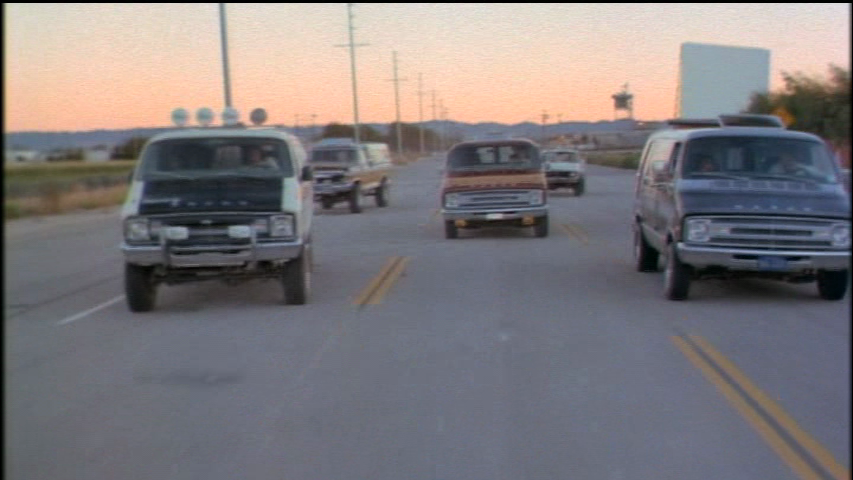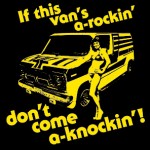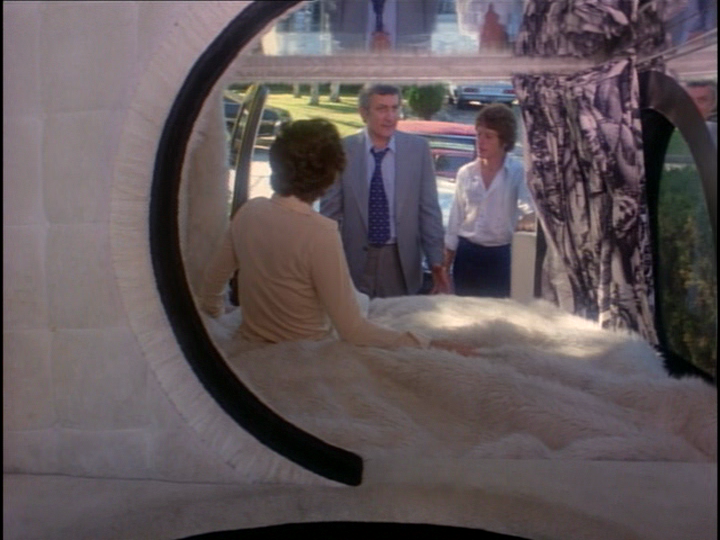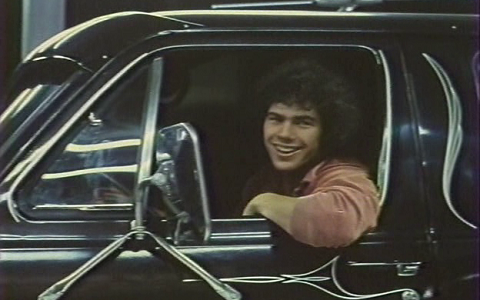Jason Coffman’s fantastic journey into the world of the “Vansploitation” films of the 1970s was originally published for the online magazine Fine Print. We are pleased to re-present it here on Daily Grindhouse in several parts.
Many die-hard film fans, critics and other film writers maintain that the 1970s was the finest decade for American film, and it is not hard to see why. Established names were on the rise, knocking out masterpieces left and right, and the expanding borders of what could be depicted in a mainstream film were redefining what could be projected onto the big screen. Exploitation films, long a staple of drive-ins and low-rent movie houses, exploded in all directions. The major studios joined in when low-budget exploitation films began showing cost-to-profit margins that put the big-budget blockbusters to shame. It seems that every possible subject that could be exploited was getting its moment in the spotlight. Even the Book of Revelations got its own low-budget contemporary adaptation in Donald W. Thompson’s A THIEF IN THE NIGHT films, which brought a contemporary Biblical apocalypse to the big screen. The possibilities open to filmmakers on any level seemed limitless.
So naturally, there was a movement of Van movies.

Detail of the mural painted on “Paranoia,” one of the dozens of vans in “Supervan” (1977).
Where Did Vansploitation Come From?
“Vansploitation” movies were not the first and certainly not the last set of films based on a pop culture fad. The roots of the van movie reach back most obviously to the 1950s, when movies about cars became popular studio fare for the evolving teen film market. Fast cars, open roads and dangerous games of “chicken” both signified a potentially hazardous teenage freedom and (even better) they made the squares nervous. B-movies about teens driving recklessly all played expertly on the growing sense of unrest and rebellion in the youth of America. Hot Rods became a symbol of an increasingly yawning generation gap, one that only became wider in the 1960s as American youth clashed with their elders over civil rights, sexual liberation, and the Vietnam war.
By the mid-1960s, Hot Rods were being replaced with motorcycles. If the “Hot Rod” gangs in the films of the 1950s made parents nervous, the biker gangs of 1960s B-movies must have had them terrified. Roger Corman, who had produced such 50’s teen epics as HOT CAR GIRL, T-BIRD GANG and TEENAGE CAVEMAN, opened the floodgates for the biker movie cycle with his 1966 film THE WILD ANGELS. The film laid out a blueprint for a legion of copy-cat films to follow, all of them giving young audiences a taste of the life that could be theirs for the taking by hopping on a bike and running roughshod– sometimes literally– over everything their parents held dear. This romantic ideal of the open road as rejection of traditional values was so powerful that biker movies continued to enjoy popularity after EASY RIDER, a massively successful film that nevertheless pointedly highlighted what happens if your rebellion lacks substance.
Vansploitation cinema was born in the 1970s, combining the freewheeling freedom of the motorized vehicle with a slightly more jaded understanding about its limits. The first proper “Vansplotation” movie, writer/director Chuck Vincent’s 1972 film BLUE SUMMER (aka LOVE TRUCK) starts as a celebration of the good life on the road, but by the end of this film, this is unmasked as an illusion, a cruel lie exposed in the face of the inevitable responsibilities of adulthood. In this, BLUE SUMMER both points toward the form and content of Vansploitation films to follow and the genre’s inevitable demise. However, the seeds were clearly planted for the crop of Vansploitation films that would follow later in the decade.

The graceful, balletic Dance of the Vans in “Mag Wheels” (aka “Summer School,” 1978).
Unsurprisingly, the genre did not survive the transition into the Reagan 80’s, as its association with both hippies and blue-collar workers (most notably long haul truckers) instantly made the genre passé in the profit-driven white-collar culture that came to define that decade. In 1977, teenagers were going to the drive-in to see Bobby try to get laid in THE VAN; by 1987, they were going to the multiplex at the mall to watch Michael J. Fox try to jump some of the rungs on the corporate ladder in THE SECRET OF MY SUCCESS. Sure, he was also getting laid, but unlike Bobby in THE VAN, the sex was a means to an end and not the goal itself. 1987 was the same year CAN’T BUY ME LOVE was released, in which a nerd (Patrick Dempsey) pays a popular cheerleader $1000 to pose as his girlfriend. It’s not hard to notice a trend in the increasing commoditization of sex and relationships in films of the 1980s, and it makes perfect sense as a capper to the decade that one of the biggest hits of 1990 was Garry Marshall’s PRETTY WOMAN.
Vansploitation films depended on the vans being a means to an end (most notably sex); as audiences became more “sophisticated,” sex itself became the means to more tangible, material ends. No longer did the male protagonist of the teen sex comedy need to use his awesome van to catch any girl for sex—now he needed to have sex with the right girl who could enhance his status, popularity, etc. In the 1980s, Bobby’s van would no longer be a point of pride and something he could use to impress the opposite sex, but his skill in negotiating a better interest rate on his van loan might be.
Why Vans?
 In the 1950s, one of the reasons teens wanted their own cars was so they would have a place to make out undisturbed. The van culture of the 1970s, and especially Vansploitation films, made no bones about this particular aspect of van ownership. In the 50s, kids would make out in cars because they were convenient. In the 60s, they could hop on a bike and do it anywhere, although no doubt many non-hippies found themselves uncomfortable getting naked in the great outdoors.
In the 1950s, one of the reasons teens wanted their own cars was so they would have a place to make out undisturbed. The van culture of the 1970s, and especially Vansploitation films, made no bones about this particular aspect of van ownership. In the 50s, kids would make out in cars because they were convenient. In the 60s, they could hop on a bike and do it anywhere, although no doubt many non-hippies found themselves uncomfortable getting naked in the great outdoors.
The van offered the perfect solution: the freedom of a motor vehicle to go anywhere combined with some of the comforts of indoor living, such as an actual bed. The vans in Vansploitation movies usually went all-out, featuring not only beds but wall-to-wall carpeting, televisions, refrigerators and all manner of creature comforts and custom styling.
The rise in popularity of custom vans also dovetailed with another 70’s craze for Citizen’s Band (or C.B.) radio and a pop culture obsession with the long-haul trucker. In response to the Arab oil embargo in 1973, the United States implemented a nationwide 55 mph speed limit and severe rationing and rules on gas consumption were commonplace. The new speed limit and skyrocketing price of fuel put long-haul truckers in a difficult position: in order to keep up their standard delivery schedules, they were all but guaranteed to run afoul of police enforcing the new speed limit, and the price of fuel made it tougher for them to get by on their pay since more and more of it had to go into their gas tanks. The C.B. radio provided a handy solution, allowing truckers to keep each other up to date on where to buy gas and where to watch out for speed traps.

Ziggy’s ultimate C.B. radio setup from “On the Air Live with Captain Midnight” (1979).
Perhaps the tipping point at which the popularity of C.B. radio spilled into the public at large was the eventual strikes held by truckers in protest of the speed limits. A series of strikes across the country led to the romanticizing of the long-haul trucker as a noble post-Vietnam rogue sticking up for himself and railing against the injustices of the system, using their C.B. radios as a tool to stick it to The Man. Eventually the C.B. radio craze exploded and the airwaves became a sort of massive, anarchic proto-Internet chat room, where truckers, police, and a legion of private citizens used the radio to communicate with each other on anything and everything.
In a way, the van was an appealing way for drivers in the 70s to imitate their 18-wheeler film and television heroes. The van offered the same kind of freedom that the truckers enjoyed with two major advantages: a driver did not need a special license to drive a van, and the van was not tied (at least directly) to the responsibility of working for a living. Van trips offered people a taste of the romanticized trucker lifestyle, an illusion reinforced by the C.B. radios that were virtually standard issue in custom vans. The Vansploitation film depicts drivers playing at being idealized nomads of the highways, pretending (and/or hoping) that their van would deliver them into the same kind of lifestyle as, say, BJ and the Bear or those guys from the song “Convoy.”
What Is A Vansploitation Movie?
For the purposes of this discussion, it may be helpful to provide a more detailed definition of what constitutes a Vansploitation movie. Obviously, a van movie must have one or more vans in it, but the simple appearance of a van does not indicate that the film in question is Vansploitation. Otherwise, THE TEXAS CHAIN SAW MASSACRE would count. The van (or vans) must fulfill certain functions relating to the plot of the film. The trailer for VAN NUYS BLVD. actually spelled out the principal functions of the van in Vansploitation films perfectly: “Freedom, fun and fine transportation.” The vans in Vansploitation films are a symbol of the characters’ sense of freedom, usually their main leisure activity is driving the vans, and the customization and comfort provides the “fine transportation.
Additionally, the van (or vans) must provide the engine that drives the plot forward and/or provide the stage in which the action of the plot actually takes place. Most Vansploitation movies have extremely simple plot lines that make maximum use of the large interiors of the vans depicted. The interior of a van, after all, provides a cheap, mobile set that can be easily redressed as needed. The characters in Vansploitation films generally have goals oriented toward spending as much time in their van as possible, or in putting money into improving their van’s performance and/or appearance via customization (both “under the hood” improvements and the sort of Dungeons & Dragons murals often associated with 70s vans) . In short, most van movies are about getting laid (in a van) and winning road games or other competitions (also in a van).

Bobby shows his parents the interior of the Straight Arrow in “The Van” (1977).
Finally, a Vansploitation film must meet the standard criteria for identifying all classical exploitation film as described by Eric Schaefer in his book Bold! Daring! Shocking! True!: A History of Exploitation Films 1919-1959: the film must exploit a marketable angle (in this case, obviously vans), be made with low production values, be distributed independently of the major studios, mostly play in independent venues, and have few prints in circulation at any given time. While Schaefer’s book mostly refers to the distribution model that existed in the first half of the 20th century, it is simple enough to substitute the drive-ins and grindhouses that were popular in the 70s for the non-studio owned independent theaters where classical exploitation filmmakers plied their trade. Additionally, most Vansploitation films were distributed by small independent companies rather than major studios, they were clearly made on low budgets and likely distributed regionally (playing different parts of the country as bookings and available prints permitted).
What Are the Essential Texts of Vansploitation Cinema?
Perhaps unsurprisingly, Vansploitation is not a crowded genre. For purposes of this discussion, the essential texts of the Vansploitation cycle are:
BLUE SUMMER (aka LOVE TRUCK) – 1973, directed by Chuck Vincent;
C.B HUSTLERS – 1976, directed by Stu Segall;
THE VAN – 1977, directed by Sam Grossman;
SUPERVAN – 1977, directed by Lamar Card;
MAG WHEELS (aka SUMMER SCHOOL) – 1978, directed by Bethel Buckalew; and
VAN NUYS BLVD. – 1979, directed by William Sachs.
Each of these films were made with low budgets and distributed independently. The film that would be the last of the Vansploitation films, ON THE AIR LIVE WITH CAPTAIN MIDNIGHT (1979, directed by Beverly and Ferd Sebastian), was distributed by Columbia Pictures and therefore is disqualified from inclusion in the cycle. Still, the film is worth discussing here even if it technically falls outside the realm of Vansploitation cinema.
Join us all this week for Jason’s look at the essential works of Vansploitation, and check out our review of the documentary VANNIN’ here!
-Jason Coffman
- [CINEPOCALYPSE 2017] FIVE FILMS YOU CAN’T MISS AT CINEPOCALYPSE! - October 31, 2017
- Hop into Jason’s Ride for a Look at the Wild World of Vansploitation! - August 11, 2014



I’m not sure how vans fared in other part of the western world. But I know that CB radios and car-based vans (locally called Panel Vans) became incredibly popular in Australia for the very same era as American’s van culture. You get a sense of that in Australian movies such as The FJ Holden (1976) and Puberty Blues (1981). Type “Holden Sandman” into Google Images and you’ll see the kind of van that young people aspired to own at the time.